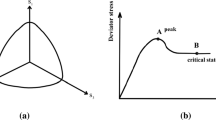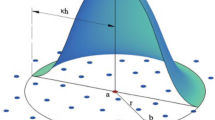Abstract
In this paper, a dynamic programming method is employed in conjunction with limit-equilibrium techniques to determine the location of the non-circular critical slip surface in the analysis of a slope failure due to a rainfall event. The Spencer method of slope stability analysis was incorporated into dynamic programming to predict the time of a slope failure and shape of the failure surface. A one-Dimensional (1D) sliding block model was used to analyze the motion of the failure mass. Furthermore, during the movement of the sliding mass, the stability of the model slope was analyzed by updating the shape of the model slope according to the new position of the sliding mass. The suction head in the soil pore provides soil shear strength to maintain the stability of the slope. The positive pore water pressure reduces the soil shear strength so that the slip surface beneath the water table will be more unstable. Numerous studies (using non-cohesive soil) have been conducted to locate the critical slip surface in slope stability problems without considering the increase in shear strength due to suction and apparent cohesion. The studies do not clearly illustrate the reasonable boundary conditions to avoid the slip surface alignment totally outside the actual slope. This paper clearly discusses the boundary conditions for such a slope stability problem reasonably. The step-by-step calculation procedure is presented through the flow diagram. Three cases of slope failure obtained from a laboratory flume experiment have been analyzed using the proposed method. The numerical simulation results and the results obtained from experiments are comparable.
Similar content being viewed by others
References
Awal, R., Nakagawa, H., Kawaike, K., Baba, Y., and Zhang, H. (2008). “Prediction of flood/debris flow hydrograph due to landslide dam failure by overtopping and sliding.” Annuals of Disaster Prevention Research Institute, Kyoto University, Japan, No. 51 B, pp. 603–611.
Baker, R. (1980). “Determination of the critical slip surface in slope stability computations.” International Journal for Numerical and Analytical Methods in Geomechanics, Vol. 4, No. 4, pp. 333–359, DOI: 10.1002/nag.1610040405.
Baker, R. and Garber, M. (1977). “Variational approach to slope stability.” Proc., 9th Int. Conference on Soil Mechanics and Foundation Engineering, Tokyo, Japan, Japanese Society for Soil Mechanics and Foundation Engineering, Vol. 2, pp. 9–12.
Baker, R. and Garber, M. (1978). “Theoretical analysis of the stability of slopes.” Geotechnique, Vol. 28, No. 4, pp. 395–411, DOI: 10.1680/geot.1978.28.4.395.
Bardet, J. P. and Kapuskar, M. M. (1989). “A simplex analysis of slope stability.” Computers and Geotechnics, Vol. 8, No. 4, pp. 329–348, DOI: 10.1016/0266-352X(89)90039-6.
Bellman, R. (1957). Dynamic programming, Princeton University Press, Princeton, New Jersey, USA.
Bishop, A. W. (1955). “The use of the slip circle in the stability analysis of slopes.” Geotechnique, Vol. 5, No. 1, pp. 7–17, DOI: 10.1680/geot.1955.5.1.7.
Fellenius, W. (1963). “Calculation of the stability of earth dams.” Trans., 2nd Congress on Large Dams, International Commission on Large Dams of the World Power Conference, Washington, D.C., Vol. 4, pp. 445–459.
Janbu, N., (1973). “Slope stability computations.” Embankment Dam Engineering, Casagrande memorial volume, John Wiley, New York, pp. 47–86.
Luceno, A. and Castillo, E. (1980). “Evaluation of variational methods in slope analysis.” Proc. 1st Int. Symposium on Landslides, Sarita Prakashan, New-Delhi, India, Vol. 1, pp. 255–258.
Morgenstern, N. R. and Price, V. E. (1965). “The analysis of the stability of general slip surfaces.” Geotechinque, Vol. 15, No. 1, pp. 79–93, DOI: 10.1680/geot.1965.15.1.79.
Pham, H. T. V., Fredlund, D. G., and Gitirana Jr., G. F. N. (2001). “Slope stability analysis using dynamic programming combined with finite element stress analysis.” Int. Conference on Management of the Land and Water Resources, MLWR, Hanoi, Vietnam, Vol. 1, pp. 107–114.
Regmi, R. K., Jung, K., Nakagawa, H., and Ide, T. (2013). “Study on multi-stages landslide due to rainfall.” Proc., 12th Int. Symposium on River sedimentation, Advances in River Sediment Research, Taylor & Francis Group, London, pp. 99–108.
Regmi, R. K., Nakagawa, H., Kawaike, K., Baba, Y., and Zhang, H. (2010). “Two and three dimensional slope stability analysis of landslide dam failure due to sliding.” Annuals of Disaster Prevention Research Institute, Kyoto University, Japan, No. 53 B, pp. 617–627.
Sarma, S. K. (1973). “Stability analysis of embankments and slopes.” Geotechnique, Vol. 23, No. 3, pp. 423–433, DOI: 10.1680/geot.1973.23.3.423.
Spencer, E. (1967). “A method of analysis of the stability of embankments assuming parallel inter-slice forces.” Geotechnique, Vol. 17, No. 1, pp. 11–26, DOI: 10.1680/geot.1967.17.1.11.
Tsutsumi, D. and Fujita, M. (2008). “Relative importance of slope material properties and timing of rain fall for the occurrence of landslides.” International Journal of Erosion Control Engineering, IJECE, Vol. 1, No. 2, pp. 79–89, DOI: 10.13101/ijece.1.79.
Yamagami, T. and Ueta, Y. (1988). “Search for critical slip lines in finite element stress fields by dynamic programming.” Proc., 6th Int. Conference on Numerical Methods in Geomechanics, Balkema, Rotterdam, Netherlands, Vols. 1–3, pp. 1347–1352.
Author information
Authors and Affiliations
Corresponding author
Rights and permissions
About this article
Cite this article
Regmi, R.K., Jung, K. Application of dynamic programming to locate the critical failure surface in a rainfall induced slope failure problem. KSCE J Civ Eng 20, 452–462 (2016). https://doi.org/10.1007/s12205-015-0183-9
Received:
Revised:
Accepted:
Published:
Issue Date:
DOI: https://doi.org/10.1007/s12205-015-0183-9




